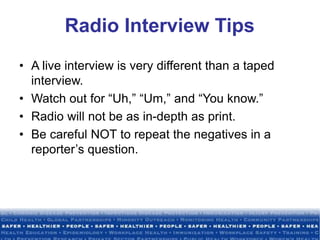This document provides guidance for spokespeople communicating during emergencies. It discusses the role of spokespeople, necessary qualities, and tips for interacting with the public and media. Effective spokespeople embody their organization, acknowledge uncertainty, and focus on solutions rather than criticisms. When speaking to upset groups, spokespeople should listen actively and avoid personal attacks. Media interviews require preparation, concise responses, and refusing to speculate. Spokespeople must represent their organization with credibility and calmness during a crisis.



























![Sensational or Unrelated
Questions
“Bridges” back to what you want to say:
• “What I think you are really asking is . . .”
• “The overall issue is . . .”
• “What’s important to remember is . . .”
• “It’s our policy to not discuss [topic], but what I
can tell you . . .”](https://image.slidesharecdn.com/spokesperson-231117174712-fdb6363b/85/Spokesperson-ppt-28-320.jpg)


















